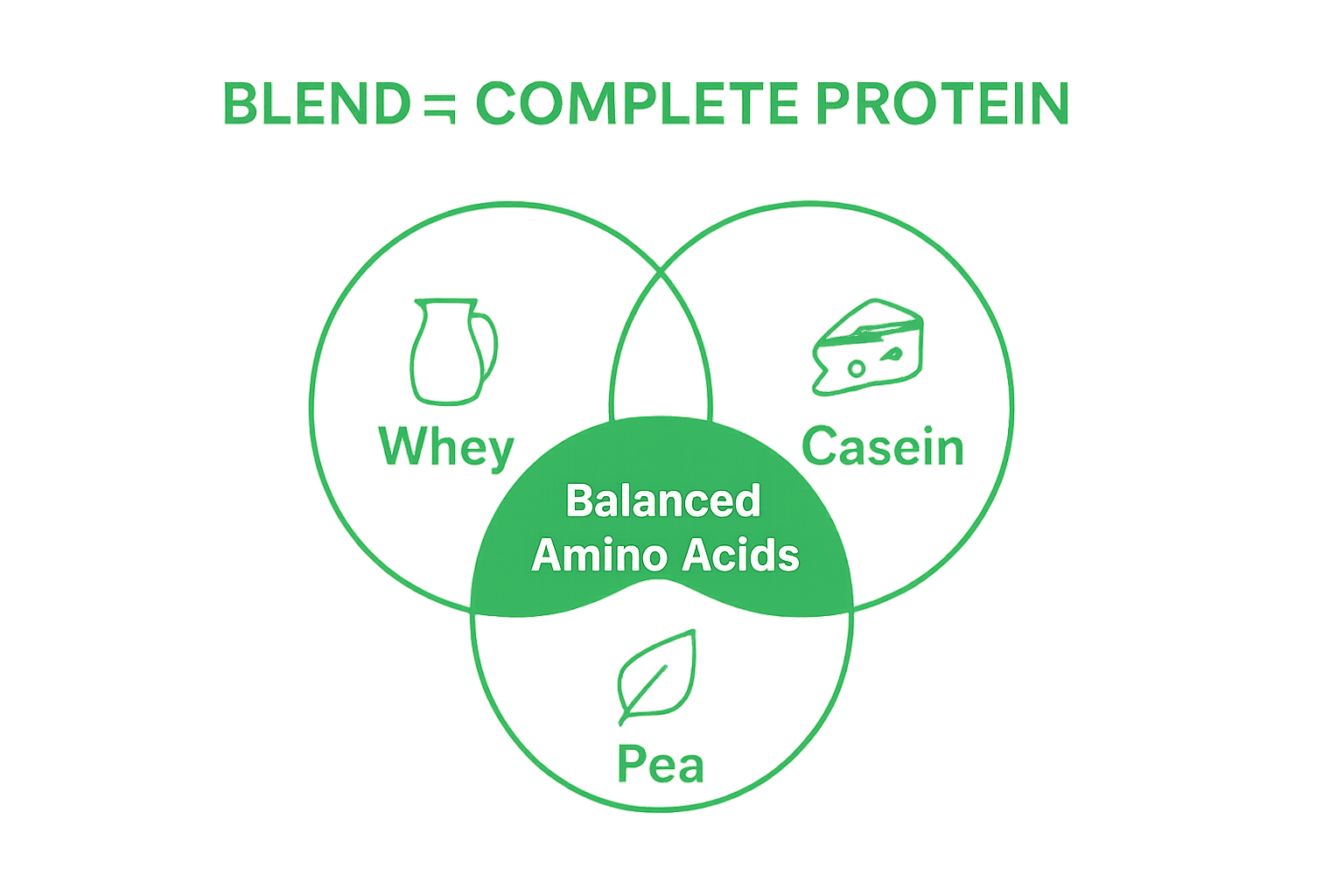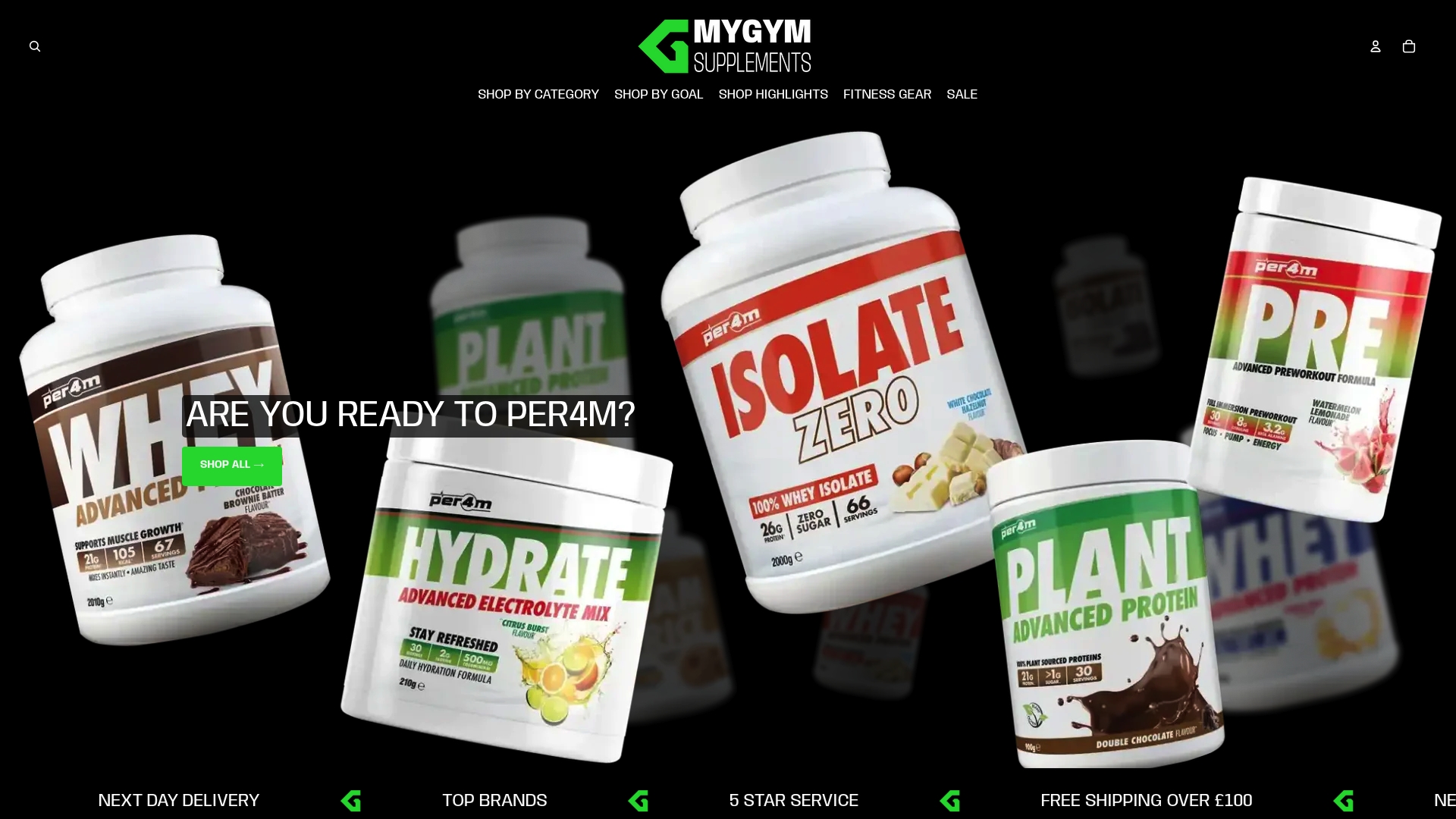
Protein blends might sound like just another supplement trend, yet their smart design actually changes how your body absorbs nutrients. Most people reach for a single protein powder after the gym, thinking it is enough. But research shows that combinations of proteins like whey, casein, and peas can enhance muscle synthesis more than any one type alone. The real surprise is that these blends are not just for bodybuilders or athletes—they offer unique advantages for anyone needing steady nutrition, from older adults to busy parents.
Table of Contents
- Defining Protein Blend: What It Is And Its Components
- The Importance Of Protein In Diet: Why Protein Blend Matters
- How Protein Blends Work: The Science Behind Their Effectiveness
- Types Of Protein Sources In Blends: Understanding Their Properties
- Real-World Applications: Who Benefits From Protein Blends?
Quick Summary
| Takeaway | Explanation |
|---|---|
| Protein blends improve amino acid absorption. | Combining different protein sources enhances the delivery and absorption of essential amino acids for better nutrition. |
| Athletes benefit from sustained protein release. | Protein blends help maintain a steady supply of amino acids, aiding muscle recovery and performance during intense training. |
| Different proteins digest at varying rates. | Using a mix of fast, medium, and slow-digesting proteins ensures prolonged nutrient availability for overall health. |
| Protein blends support diverse dietary needs. | They cater to various dietary preferences, helping those with restrictions obtain balanced nutrition without compromising on quality. |
| Strategic combinations enhance nutrient profiles. | Blending proteins ensures a comprehensive amino acid profile, making them more effective than single-source supplements. |
Defining Protein Blend: What It Is and Its Components
A protein blend represents a sophisticated nutritional strategy where multiple protein sources are strategically combined to maximise nutritional benefits and absorption rates. Unlike single-source protein supplements, protein blends integrate different protein types to create a more comprehensive nutritional profile.
The Composition of Protein Blends
Protein blends typically incorporate proteins derived from diverse sources such as whey, casein, egg, and plant-based proteins like pea, hemp, and rice. According to Harvard’s Nutrition Source, these combinations are designed to provide a balanced amino acid profile that supports multiple physiological functions.
The strategic mix often includes proteins with varying digestion rates:
- Fast-absorbing proteins like whey, which rapidly deliver amino acids
- Medium-absorbing proteins such as egg proteins
- Slow-absorbing proteins like casein, which provide sustained amino acid release
Why Protein Blends Matter
The primary advantage of protein blends lies in their ability to offer sustained protein absorption. While single-source proteins might provide quick or slow nutrient delivery, blends create a more balanced and prolonged amino acid availability. Research from sports nutrition studies demonstrates that mixed protein sources can enhance muscle protein synthesis more effectively than isolated protein types.
Athletes, bodybuilders, and fitness enthusiasts particularly benefit from protein blends because they support continuous muscle recovery and growth by maintaining a consistent amino acid environment in the body. The carefully crafted combination ensures that muscles receive a steady stream of essential nutrients throughout the day and during recovery periods.
The Importance of Protein in Diet: Why Protein Blend Matters
Protein represents a fundamental macronutrient essential for numerous bodily functions, far beyond muscle development. Understanding protein’s multifaceted role helps explain why strategic protein blends have become increasingly important in modern nutrition.
Physiological Functions of Protein
Proteins serve as critical building blocks for virtually every cellular process. They are fundamental in constructing enzymes, hormones, antibodies, and structural components that maintain human health. According to clinical nutrition research, protein consumption impacts multiple physiological systems:
The table below outlines the physiological functions of protein, as discussed in the article, to illustrate the broad impact of adequate protein intake in the human body.
| Physiological Function | Role of Protein |
|---|---|
| Muscle Maintenance | Supports muscle protein synthesis and repair |
| Immune Function | Forms antibodies and immune system components |
| Metabolic Regulation | Essential for enzyme production and hormonal balance |
| Cellular Repair | Enables tissue regeneration and wound healing |
- Muscle Maintenance: Supports muscle protein synthesis and repair
- Immune Function: Helps create antibodies and immune system components
- Metabolic Regulation: Assists in enzyme production and hormonal balance
- Cellular Repair: Enables tissue regeneration and wound healing
Nutritional Challenges and Protein Blends
Modern dietary patterns often present challenges in obtaining comprehensive protein nutrition. Many individuals struggle to consume diverse protein sources that provide a complete amino acid profile. Protein blends offer a sophisticated solution by combining proteins from multiple sources, ensuring a more balanced nutrient intake.
This approach becomes particularly crucial for athletes, fitness enthusiasts, and individuals with specific dietary requirements. By integrating varied protein sources, protein blends can address nutritional gaps and support optimal physical performance.
Furthermore, protein blends provide a flexible nutritional strategy that accommodates different dietary preferences, including vegetarian, vegan, and omnivorous eating patterns. Learn more about our protein supplement range to discover tailored nutritional solutions that meet your specific health and fitness goals.
How Protein Blends Work: The Science Behind Their Effectiveness
Protein blends are not simply random protein combinations, but scientifically engineered nutritional strategies designed to optimise amino acid delivery and absorption. Understanding their intricate biochemical mechanisms reveals why these complex formulations offer superior nutritional benefits.
Absorption Kinetics and Protein Synthesis
The effectiveness of protein blends stems from their unique ability to manage protein absorption rates. Clinical research demonstrates that different protein sources have distinct digestion velocities, which can be strategically combined to create a sustained amino acid release profile.
These absorption profiles are characterised by:
- Rapid Proteins: Whey proteins that provide immediate amino acid availability
- Intermediate Proteins: Egg proteins with moderate absorption rates
- Slow-Release Proteins: Casein proteins that provide prolonged nutrient delivery
Amino Acid Profile Optimization
Protein blends go beyond simple absorption management. They are meticulously formulated to balance essential amino acid compositions, ensuring comprehensive nutritional support. Nutritional studies reveal that thoughtfully constructed protein blends can match or even surpass single-source protein supplements in supporting muscle protein synthesis.
The strategic combination of protein sources allows for:
- Enhanced amino acid profile completeness
- Improved nitrogen retention
- More consistent muscle protein synthesis stimulation
For fitness enthusiasts seeking advanced nutritional strategies, explore our comprehensive protein supplement guide to understand how these scientific principles translate into practical nutrition.
Types of Protein Sources in Blends: Understanding Their Properties
Protein blends represent a sophisticated nutritional approach that combines various protein sources, each bringing unique characteristics and benefits to the overall nutritional profile. Understanding the distinct properties of different protein types is crucial for creating effective and balanced nutritional strategies.
Animal-Based Protein Sources
Comprehensive nutritional research reveals that animal-based proteins generally offer superior amino acid profiles and digestibility. These protein sources include:
- Whey Protein: Rapidly absorbed, rich in branched-chain amino acids
- Casein Protein: Slow-digesting, provides sustained amino acid release
- Egg Protein: Moderate absorption rate, complete amino acid profile
- Milk Protein: Combination of whey and casein, offering mixed absorption characteristics
Whey protein, in particular, stands out for its rapid absorption and high leucine content, making it exceptional for immediate post-exercise muscle recovery. Casein, conversely, forms a gel-like substance in the stomach, enabling a slower, more prolonged nutrient release.
Plant-Based Protein Sources
Plant-based proteins have gained significant traction among health-conscious consumers and those with dietary restrictions. These proteins typically require strategic blending to overcome individual amino acid limitations:
- Pea Protein: High in arginine and lysine
- Rice Protein: Complementary amino acid profile
- Hemp Protein: Rich in omega-3 fatty acids
- Soy Protein: Complete protein with all essential amino acids
Unlike animal proteins, plant proteins often need careful combination to create a comprehensive amino acid profile.
To clarify the unique characteristics and benefits of various protein sources often included in blends, the following table provides a side-by-side comparison of key animal and plant-based proteins highlighted in the article.
| Protein Source | Type | Absorption Rate | Key Advantages |
|---|---|---|---|
| Whey | Animal-based | Fast | High in BCAAs, rapid muscle recovery |
| Casein | Animal-based | Slow | Sustained amino acid release |
| Egg | Animal-based | Medium | Complete amino acid profile |
| Milk | Animal-based | Mixed | Combination of fast and slow digestion |
| Pea | Plant-based | Medium | Rich in arginine and lysine |
| Rice | Plant-based | Medium | Complementary amino acid content |
| Hemp | Plant-based | Medium | Contains omega-3 fatty acids |
| Soy | Plant-based | Medium | Complete plant protein |

Nutritional strategies frequently involve mixing different plant proteins to achieve a more balanced nutritional composition.
For fitness enthusiasts looking to explore personalised nutrition, check out our protein supplement collection to find blends tailored to your specific dietary needs and fitness goals.
Real-World Applications: Who Benefits from Protein Blends?
Protein blends are not a one-size-fits-all solution but a versatile nutritional strategy tailored to meet diverse physiological needs across different populations. Understanding the specific benefits for various groups reveals the true potential of these sophisticated nutritional formulations.
Athletes and Fitness Enthusiasts
Clinical research demonstrates that protein blends offer significant advantages for athletes seeking optimal performance and recovery. These nutritional strategies provide sustained amino acid delivery, supporting multiple physiological processes:
- Rapid Muscle Recovery: Immediate and prolonged protein synthesis support
- Enhanced Performance: Consistent energy and nutrient availability
- Reduced Muscle Breakdown: Continuous amino acid supply during intense training
For athletes following diverse dietary approaches, protein blends offer remarkable flexibility. Plant-based athletes, in particular, can leverage strategically designed protein combinations to match the amino acid profiles traditionally obtained from animal sources.
Age-Related Nutritional Challenges
Protein blends play a crucial role in addressing nutritional requirements across different life stages. Longitudinal studies highlight their importance for specific demographic groups:
- Older Adults: Combating age-related muscle loss and maintaining physical performance
- Adolescents: Supporting growth and development with balanced protein intake
- Individuals with Dietary Restrictions: Providing comprehensive nutrition across various dietary preferences
Specifically for older populations, protein blends can help mitigate sarcopenia risks by maintaining lean muscle mass and supporting overall physical function. The sustained amino acid release becomes particularly beneficial as metabolic efficiency naturally declines with age.

Explore our personalised nutrition solutions to discover how targeted protein blends can support your unique health and fitness journey.
Are You Struggling to Get the Right Protein Balance? Discover an Easier Solution
Many athletes and health enthusiasts find themselves stuck trying to create the perfect protein routine, often juggling different sources that leave nutritional gaps. This article explained how protein blends address these challenges by delivering a steady supply of amino acids and bridging the gap between fast and slow absorption for truly effective muscle recovery. When you are seeking continuous energy or consistent support after a tough session, having the right blend can make all the difference.

Take away the guesswork. Visit MyGymSupplements.shop to browse our range of expertly formulated protein supplements designed to match your active lifestyle. Find options tailored for everything from faster recovery to long-lasting nourishment. Let your next workout or training session benefit from science-backed blends and begin your journey to stronger, more balanced nutrition today.
Frequently Asked Questions
What is a protein blend?
A protein blend is a nutritional supplement that combines multiple sources of protein to enhance the amino acid profile and absorption rates compared to single-source proteins. It typically includes a mix of both animal and plant-based proteins.
What are the benefits of using protein blends?
Protein blends offer several benefits, including sustained protein absorption, a balanced amino acid profile for muscle recovery and growth, and the ability to meet diverse dietary needs, making them suitable for athletes, vegetarians, and those with dietary restrictions.
How do protein blends promote muscle recovery?
Protein blends support muscle recovery by providing a steady release of amino acids from both fast and slow-digesting proteins. This helps maintain an optimal environment for muscle protein synthesis, aiding in rapid recovery after exercise.
Are protein blends suitable for people with dietary restrictions?
Yes, protein blends can be formulated to cater to various dietary restrictions, including vegan and vegetarian diets. By combining different plant-based protein sources, they can achieve a complete amino acid profile required for optimal nutrition.



0 comments